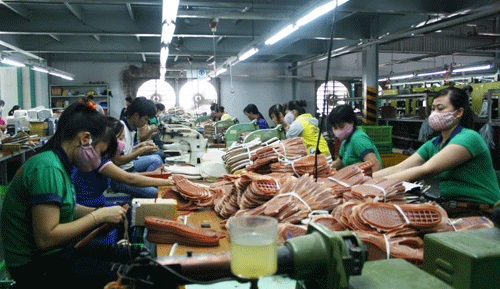Binh Duong’s footwear industry takes initiative in welcoming investment opportunities
It is predicted that the Trans-Pacific Partnership (TPP) agreement will bring advantages to Binh Duong’s leather and footwear industry if enterprises in this field take initiative in fulfilling necessary conditions.
Great opportunity for leather and footwear industry
In 2012, Vietnam’s leather and footwear export reached US$7.2bln, 31% of which came from the US with tax tariff of 12%. Vietnamese leather and footwear exports to the U.S. market have currently tax duties between 7% to 19% percent, which will be reduced to zero after the TPP agreement is implemented.
According to
Binh Duong Leather and Footwear Association, the TPP agreement will bring about
opportunities for the Vietnamese leather and footwear industry to penetrate a
large market. The US market now
accounts for 30% of Vietnam’s
leather and footwear industry’s total exports. 
Footwear products being manufactured at Dong Hung Industrial Joint Stock Company
Binh Duong is now home to around 100 leather and footwear enterprises. Their main markets are still the US and EU. Some enterprises, namely An Thinh, Chi Hung, Lien Phat, Nam Binh, Dong Hung…have achieved export contracts till year-end. In the first half of the year, province-based leather and footwear enterprises produced 18,3 mln pairs of sport shoes, up 33.9% compared to the corresponding period last year…
The TPP agreement will help Vietnamese shoe enterprises to increase their competitiveness over other major shoe exporters, including China and India that are not TPP members. Binh Duong’s leather and footwear products will also have opportunities to strongly develop in Japan, a member of the TPP agreement.
Taking initiative in joining TPP
Binh Duong’s leather and footwear enterprises will enjoy many opportunities when the TPP agreement is implemented. However, they must obey serious regulations from the TPP agreement to be able to enjoy zero export tax rates to other countries signed up to the agreement, especially the US. They need to have enough preparations to welcome investment opportunities from the TPP agreement.
But aside from advantages, the TPP agreement may bring some challenges to Viet Nam's shoes industry, as the agreement has a compulsory localization rate for raw materials. Vietnam still imports most of its raw material for leather and footwear industry, mostly from China. According to Nguyen Van Le, Vice-Chairman of Binh Duong Leather and Footwear Association, leather and footwear enterprises need to improve their localization rate in order to take initiative in welcoming investment opportunities from the TPP agreement. Seeking domestic materials is also a new way to increase competitiveness for Binh Duong’s leather and footwear products.
Mr.Le said that many enterprises in this field have bravely invested in production technologies and boosted the use of domestic materials, especially in sport shoes. Their localization rate now reaches around 55% and the figure is expected to achieve 65% by 2013. Some enterprises, namely Thai Binh, Dong Hung…are forwarding to invest in PU footwear factories. Recently, there have been many footwear patterns produced by high technologies in Vietnam.
Along with leather and footwear enterprises, the local functional agencies need to make efforts in increasing the localization rate for this field. They also need to pay more attention to FDI attraction in textile, dyeing and materials industries so that Binh Duong’s leather and football industry will be firmly on the way to development with the TPP agreement.
Reported by Khanh Vinh-Translated by K.T

